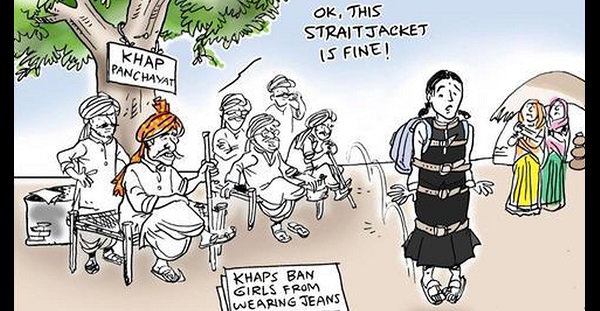Khap Panchayat in India- Functioning, Pros & Cons

In the recent years, India has been showcasing its long history of democratic institutions. Earliest examples date as far back as the 4th century. Today, India is the largest democracy. On the other hand, retrograde bodies like Khap Panchayats continue to function alongside the country’s shining examples of modern governance.

This topic of “Khap Panchayat in India- Functioning, Pros & Cons” is important from the perspective of the UPSC IAS Examination, which falls under General Studies Portion.
What are Khap Panchayats?
- The term ‘Khap’ is derived from Saka word ‘khatrap’ which refers to an area inhabited by a specific clan. This term was 1st used in the 1890-90 census report of Jodhpur.
- Khap Panchayat is a traditional assembly of elders that sets the rules and adjudicates disputes for a specific area, generally comprising of 1 or more villages. These Khaps are organized according to caste and geography.
- It is an extra-constitutional institution that emerged in the 14th century north India. It isn’t a part of the Gram Panchayat structure.
- These social institutions are prevalent in states like UP, Rajasthan and Haryana.
- The leadership of Khap Panchayats is often a hereditary position. In some cases, a community elder is asked to preside over the Khap meeting. Several other elderly men act as ‘Panches’ or judges.
- As a whole, Khap Panchayats are devoid of:
- Well-defined structure
- Formal membership
- Elective principle for its constitution
What are these institutions’ functions?
- There are 3 main functions that these institutions perform:
- Settlement of disputes between community members
- Functions as defender of religious faith
- Protection of the Khap area from external threats
- The Khap Panchayat meets to discuss several issues like:
- Marriage
- Abortion
- Dowry
- Alcohol abuse
- Non-payment of debt
- Property disputes
- Non-observance of certain social customs
- Girls’ education, etc.
- When a bigger issue arises in the region, a multi-clan council, called ‘Sarv Khap Panchayat’ is convened.
What are the pros?
- During the British colonial era, the communities came to rely on these Khap Panchayats for justice delivery. This reliance has continued to the present times.
- These institutions are said to be more in tune with the local population’s needs.
- They are capable to delivering quick justice- which makes them especially attractive to the masses, given the slow pace of the formal judicial machinery.
- The advent of mobile phones and internet technology has made convening Khap Panchayats easier than in the past.
What are the cons?
- These social institutions have no legal backing and they do not follow the rule of law in their rulings.
- Notably, the Supreme Court, in 2011, declared these institutions illegal, terming them ‘kangaroo courts’.
- They have evolved into ‘custodians of honour’. The Khap Panchayat’s decisions are committed to preserving the ‘honour’ of family, clan and village. As a result, many of their decisions are regressive, patriarchal and tending to enforce age-old taboos in the society.
- These institutions use concerning methods of punishment such as flogging, stoning, corporeal punishment and ostracizing the errant member from the community. They have been known to encourage honour killings, especially in cases of inter-faith marriages.
- Given these Khap’s stand on love and marriage, the Supreme Court has time and again reminded that these institutions and the society at large have no business interfering in individual life choices.
- They are controversial for the anti-woman tone of their rulings. For instance, Khap Panchayats prescribe dress codes for local women, prohibit use of mobile phones by women, etc.
- They mainly work as caste panchayats i.e. primarily composed of ‘upper’ and ‘middle’ caste landowning men.
- Over the years, this institution has become highly politicized. Political leadership are reluctant to go against these Khaps, considering the tremendous vote bank that they command.
- This, combined with the social sanction enjoyed by these institutions, ensure impunity. In some cases, even the family of the honour killing victims support the Khap Panchayat’s decisions. In many cases, witnesses are reluctant to testify given the clout enjoyed by the Khap.
What is the way ahead?
- Over the years, the Khap Panchayats have railed against the idea of individual liberty and free choice- principles that are guaranteed by the Indian Constitution and protected by the Supreme Court.
- Despite repeated warnings from the top court, these extra-constitutional institutions continue to give out regressive and sometimes outright harmful judgements, with impunity.
- The social and political clout enjoyed by the Khap Panchayats is the source of their immunity, despite the Supreme Court calling for stringent action against them.
- Such regressive institutions need to weeded out if India were to truly empower the women and other marginalized sections of the rural community.
- The communities must be encouraged to approach the formal judicial machinery for redressal of their issues. This calls for trust building in the Indian Judiciary, along with measures to address issues like judicial pendency and inaccessibility.
- The court has suggested several steps to address the issue of Khap Panchayats:
- Enactment of a suitable law by the Parliament to reign these institutions in
- Use of Section 144 of CrPC to prevent Khaps from assembling
- Preventive and remedial measures to prevent honour killings
Conclusion:
Over its long history, India has seen the evolution of numerous institutions for local governance. North India saw one of the earliest examples of democratic institutions and decentralized administration, of which we can be proud of. Unfortunately, Khap Panchayats isn’t one of these. It is high time to legislate to reign in these retrograde bodies.
Practice Question for Mains:
What are Khap Panchayats? Why does the Supreme Court often criticize these institutions? (250 words)

